Failure Mechanisms and Reinforcing Modes of Ply Splice Fiber-Reinforced Composite Laminates under Tensile Load
Abstract
:1. Introduction
2. Experimental
2.1. Materials and Specimens
2.2. Tensile Tests
3. Finite Element Model (FEM) Analysis/Progressive Damage Model of Composite with Ply Splices
3.1. Damage Initiation
3.2. Damage Evolution
3.3. Cohesive Zone Model for Interface
4. Results and Discussion
4.1. Failure Models
4.2. Failure Mechanism
4.3. Reinforcing Method for Ply Splices at Different Positions
4.3.1. For Ply Splices on or Near Edges
4.3.2. For Independent or Closely Bundled Ply Splices Inside a Composite
5. Conclusions
- Based on the proposed failure mechanism of unidirectional CFRP splicing with two laminates in different locations, we found that when ply splices were located on the surface, a sample underwent peel failure under the stress of S22; when ply splices were close to the surface, the continuous fibers on the outside of a sample broke first and then peel failure occurred under the stress of S22; when ply splices were independent of each other, the delamination damage of the two splicing points occurred under the shear stress S13 before the local fiber fracture; and when ply splices were close to each other, leading to early fracture of the continuous fibers between them under the tensile stress S11, delamination damage occurred. In general, the tensile strengths of samples with continuous fibers that break first were generally lower. When the fibers did not break first, the tensile strengths of samples were equivalent to that of continuous fibers.
- Some reinforcing methods were proposed. When the ply splices located or near the edge were reinforced by double-sided patches, the initial damage load increased by about 40%, and the tensile strength increased by about 10%. When the ply splices that were independent of each other were reinforced by increasing the interfacial toughness of the adhesive layer, the initial damage load increased by about 50%, and the tensile strength increased by about 5%. The tensile strength was enhanced by the two methods, especially the initial damage load was greatly increased.
Author Contributions
Funding
Acknowledgments
Conflicts of Interest
References
- Feldfogel, S.; Rabinovitch, O. Crack induced interfacial debonding in damaged RC slabs strengthened with FRP. Int. J. Fract. 2019, 215, 153–173. [Google Scholar] [CrossRef]
- Zheng, X.; Wan, B.; Huang, P.; Huang, J. Experimental study of hybrid strengthening technique using carbon fiber laminates and steel plates for reinforced concrete slabs. Constr. Build. Mater. 2019, 210, 324–337. [Google Scholar] [CrossRef]
- Jia, P.; Jiao, G.; Wang, W. Equivalent rigidity of laminate with fiber-cut splice. Prop. Anal. 2009. [Google Scholar] [CrossRef]
- Li, L.; Jia, P.; Jiao, G. Interlaminar fracture toughness of composite laminate with splicing plies. Adv. Eng. Mater. 2011, 194, 1697–1702. [Google Scholar]
- Wang, J.; Jia, P.; Jiao, G.; Wang, W.; Dai, D. Equivalent rigidity estimation of the laminate with ply splice. Sci. Technol. Eng. 2010, 3. [Google Scholar] [CrossRef]
- Wang, L.; Jia, P.; Wang, W.; Dai, D.; Jiao, G. In-plane shear strength of laminate with spliced plies. J. Mater. Sci. Eng. 2010, 3, 341–344. [Google Scholar]
- Wang, L.; Jia, P.; Jiao, G. Tensile strength of unidirectional laminate with ply-splicing. J. Mech. Strength 2013, 6, 795–798. [Google Scholar]
- Wang, L.; Jia, P.; Jiao, G.; Wang, W.; Dai, D. Mechanical property of laminate with ply splice. Prop. Anal. 2009, 126–132. [Google Scholar] [CrossRef]
- Wang, L.; Jia, P.; Liang, L. Mechanical performance of composite laminate with oblique splicing ply. New Mater. Process. 2012, 476–478, 600–604. [Google Scholar] [CrossRef]
- Wang, Q.; Jia, P.; Wang, W.; Dai, D.; Jiao, G. Study of tension strength for the laminate with ply splice. Sci. Technol. Eng. 2008, 11, 2874–2877. [Google Scholar]
- Zhong, A.; Yue, Z.; Geng, X.; Wang, B. The mechanical performance analysis and simulation method exploration of spliced ply with mesalignment seams. Chin. J. Solid Mech. 2015, 36, 111–116. [Google Scholar] [CrossRef]
- Chen, D.; Wang, M.; Arakawa, K.; Jiang, S.; Wu, K.; Hu, Q. Tensile properties of fiber reinforced epoxy resin composite with ply splice structures. Acta Mater. Compos. Sin. 2017, 11, 2473–2478. [Google Scholar]
- Huang, J.; Gen, X.; Zhang, J. Experimental and numerical research for mechanical properties of ply splice laminates. J. Appl. Mech. 2013, 5, 787–791. [Google Scholar] [CrossRef]
- Ullah, H.; Harland, A.R.; Silberschmidt, V.V. Experimental and numerical analysis of damage in woven GFRP composites under large-deflection bending. Appl. Compos. Mater. 2012, 5, 769–783. [Google Scholar] [CrossRef]
- Tarfaoui, M.; Hamitouche, L. Mode I interlaminar fracture toughness of through-thickness reinforced laminated structures. Adv. Mater. Res. 2012, 423, 154–165. [Google Scholar] [CrossRef]
- Aymerich, F.; Dore, F.; Priolo, P. Simulation of multiple delaminations in impacted cross-ply laminates using a finite element model based on cohesive interface elements. Compos. Sci. Technol. 2009, 11, 1699–1709. [Google Scholar] [CrossRef]
- Santiuste, C.; Sanchez-Saez, S.; Barbero, E. A comparison of progressive-failure criteria in the prediction of the dynamic bending failure of composite laminated beams. Compos. Struct. 2010, 10, 2406–2414. [Google Scholar] [CrossRef]
- Chen, J.; Wang, X. Tensile test and numerical simulation analysis of composite laminates with crack damage. Aeronaut. Manuf. Technol. 2017, 18, 106–109. [Google Scholar]
- Yang, Q.; Cox, B. Cohesive models for damage evolution in laminated composites. Int. J. Fract. 2005, 2, 107–137. [Google Scholar]
- Dávila, C.G.; Camanho, P.P.; Turon, A. Effective simulation of delamination in aeronautical structures using shells and cohesive elements. J. Aircr. 2008, 2, 663–672. [Google Scholar] [CrossRef]
- Camanho, P.P.; Davila, C.G.; Ambur, D.R. Numericai Simulation of Delamination Growth in Composite Materials; NASA TP-200I-21041; NASA: Washington, DC, USA, 2001.
- Zhao, Z.; Dang, H.; Xing, J.; Xi, L.; Chao, Z.; Wieslaw, K.; Binienda Yulong, L. Progressive failure simulation of notched tensile specimen for triaxially-braided composites. Materials 2019, 12, 833. [Google Scholar] [CrossRef] [PubMed]
- Garcia, C.; Trendafilova, I.; Zucchelli, A. The effect of polycaprolactone nanofibers on the dynamic and impact behavior of glass fibre reinforced polymer composites. J. Compos. Sci. 2018, 2, 43. [Google Scholar] [CrossRef]
- Garcia, C.; Trendafilova, I.; Zucchelli, A. The effect of nylon nanofibers on the dynamic behavior of GFRP composites. Matec Web Conf. 2018, 148, 14001. [Google Scholar] [CrossRef]
- ASTM D3039. Standard Test Method for Tensile Properties of Polymer Matrix Composite Materials; ASTM International: West Conshohocken, PA, USA, 2017. [Google Scholar]
- Hashin, Z. Fatigue failure criteria for unidi-rectional fiber composites. J. Appl. Mech. 1981, 48, 846–852. [Google Scholar] [CrossRef]
- Hashin, Z.; Rotem, A. A fatigue failure crite-rion for fiber reinforced materials. J. Compos. Mater. 1973, 4, 448–464. [Google Scholar] [CrossRef]
- Chang, F.K.; Chang, K.Y. A progressive dam-age model for laminated composites contain-ing stress concentrations. J. Compos. Mater. 1987, 9, 834–855. [Google Scholar] [CrossRef]
- Tserpes, K.I.; Labeas, G.; Papanikos, P. Strength prediction of bolted joints in graph-ite/epoxy composite laminates. Compos. Part B Eng. 2002, 7, 521–529. [Google Scholar] [CrossRef]
- Zhang, C.; Curiel-Sosa, J.L.; Bui, T.Q. A novel interface constitutive model for prediction of stiffness and strength in 3D braided composites. Compos. Struct. 2017, 163, 32–43. [Google Scholar] [CrossRef]
- Xie, D.; Salvi, A.G.; Sun, C.; Waas, A.M.; Caliskan, A. Discrete cohesive zone model to simulate static fracture in 2d triaxially braided carbon fiber composites. J. Compos. Mater. 2006, 22, 2025–2046. [Google Scholar] [CrossRef]
- Bank-Sills, L.; Travitzky, N.; Ashkenazi, D.; Eliasi, R. A methodology for measuring interface fracture properties of composite materials. Int. J. Fract. 1999, 3, 143–161. [Google Scholar] [CrossRef]
- Sugiman Gozali, M.H.; Setyawan, P.D. Tensile Properties and Translaminar Fracture Toughness of Glass Fiber Reinforced Unsaturated Polyester Resin Composites Aged in Distilled and Salt Water; AIP Conference Proceedings; AIP Publishing: Solo, Indonesia, 2016. [Google Scholar] [CrossRef]
- Song, M.C. Effect of translaminar reinforcements and hybridization on damage resistance and tolerance of composite laminates. Diss. Theses-Gradworks 2012, 3, 181–190. [Google Scholar] [CrossRef]
- Albedah, A.; Bouiadjra, B.B.; Mhamdia, R.; Benyahia, F.; Es-Saheb, M. Comparison between double and 493 single sided bonded composite repair with circular shape. Mater. Des. 2011, 2, 996–1000. [Google Scholar] [CrossRef]
- Xiao, J.; Xiao, Z.; Yang, J.; Xing, S.; Wen, S. Repairing performance of carbon fiber/bismaleimides composite materials. J. Natl. Univ. Def. Technol. 2016, 1, 1–8. [Google Scholar] [CrossRef]

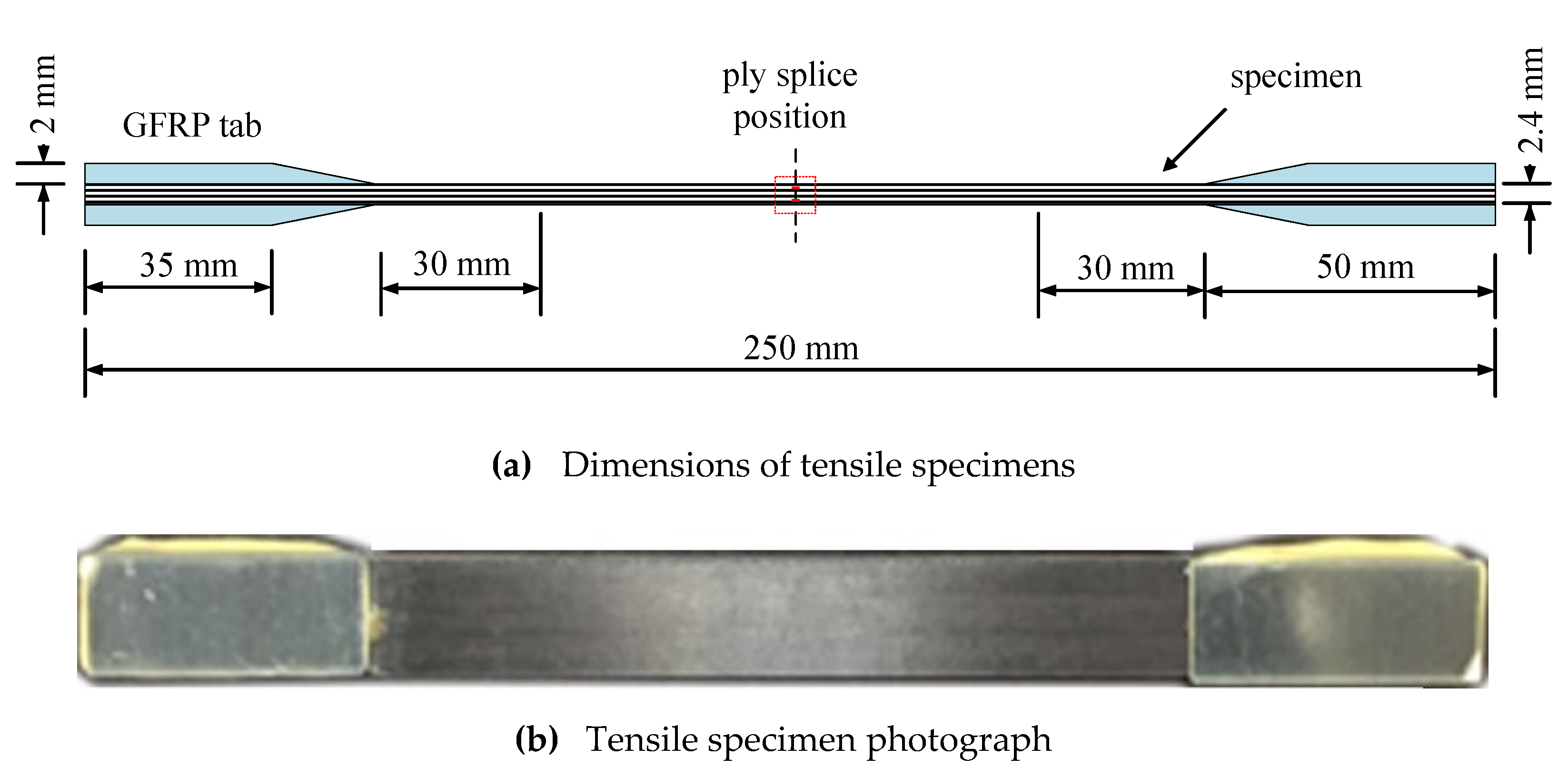
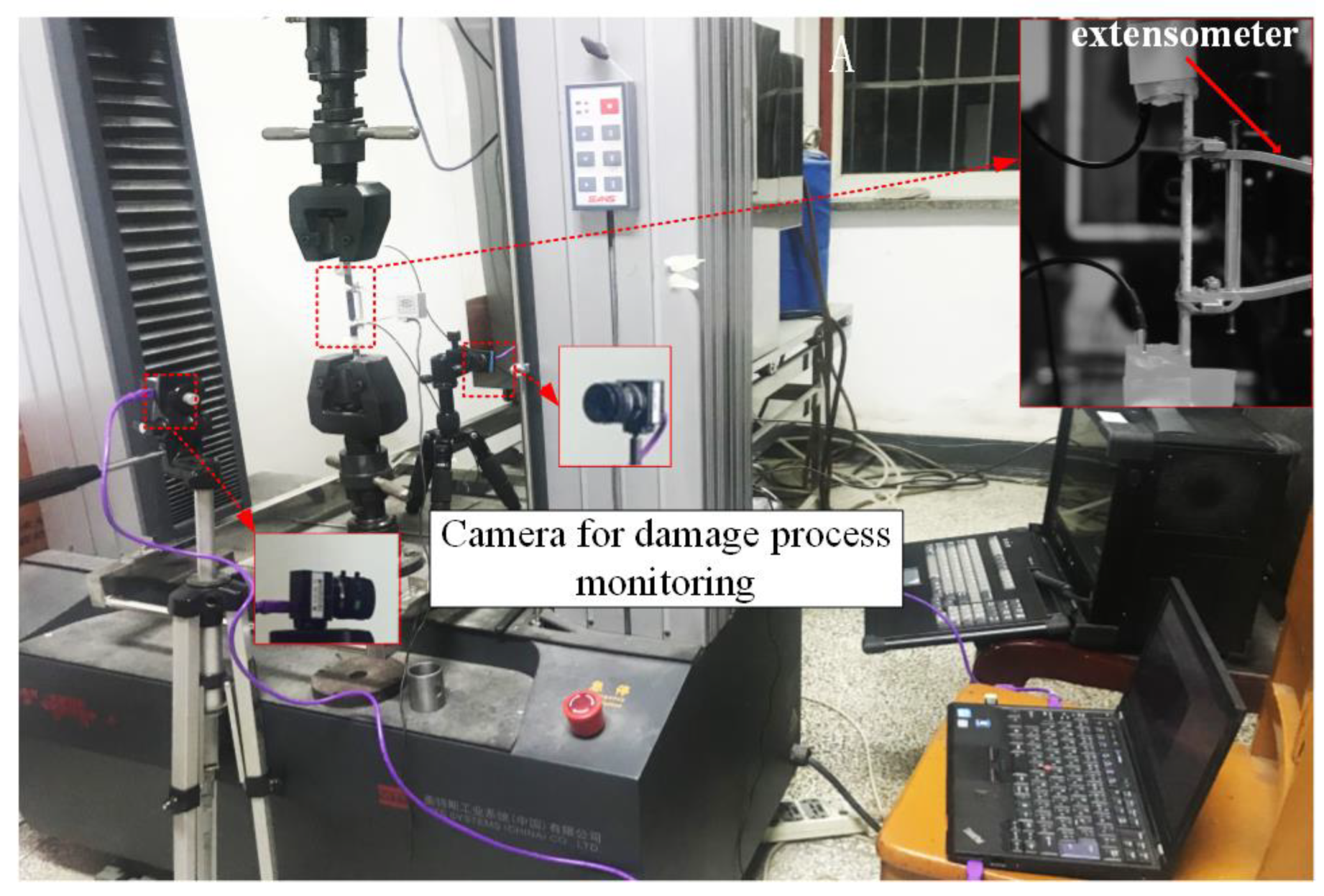


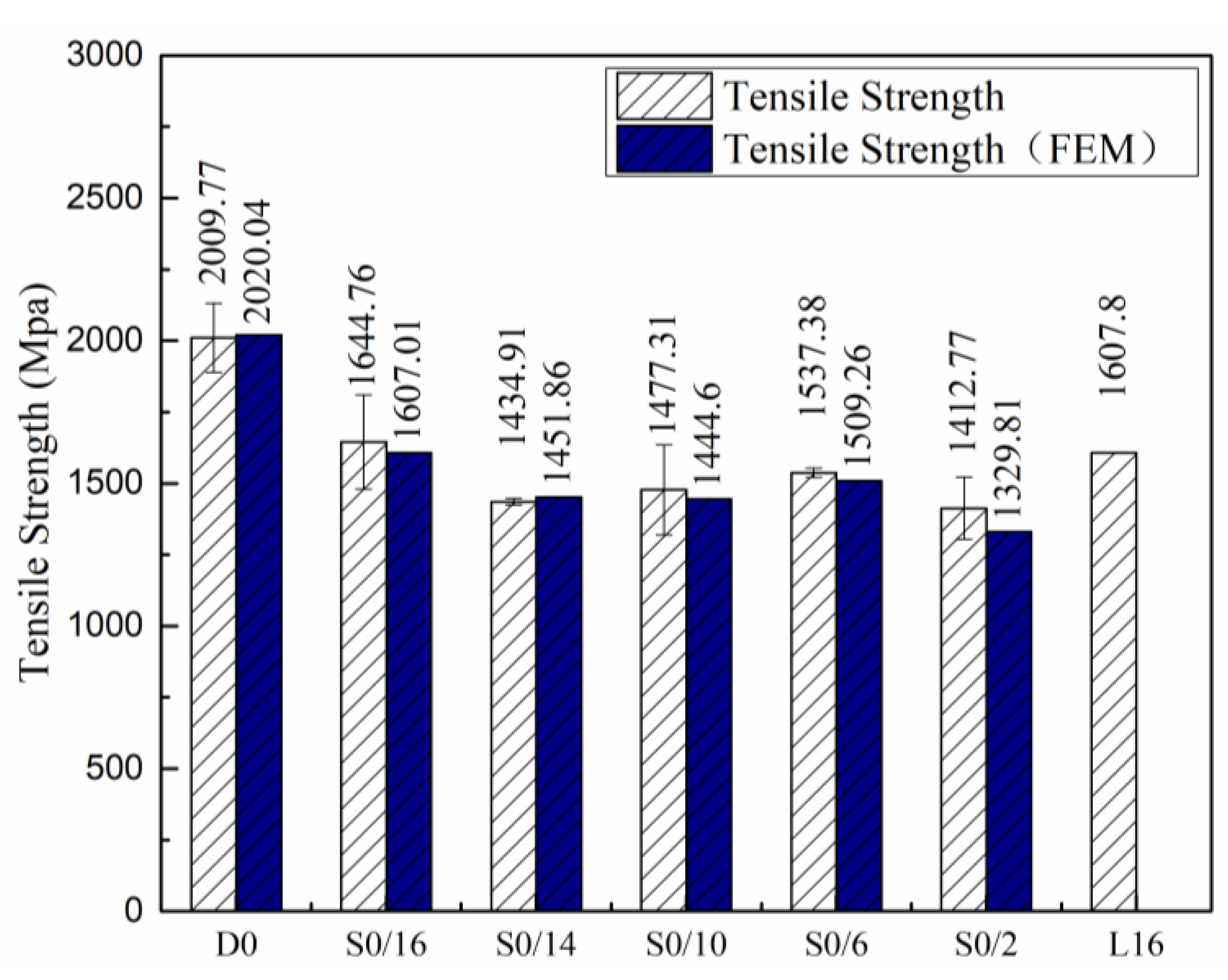

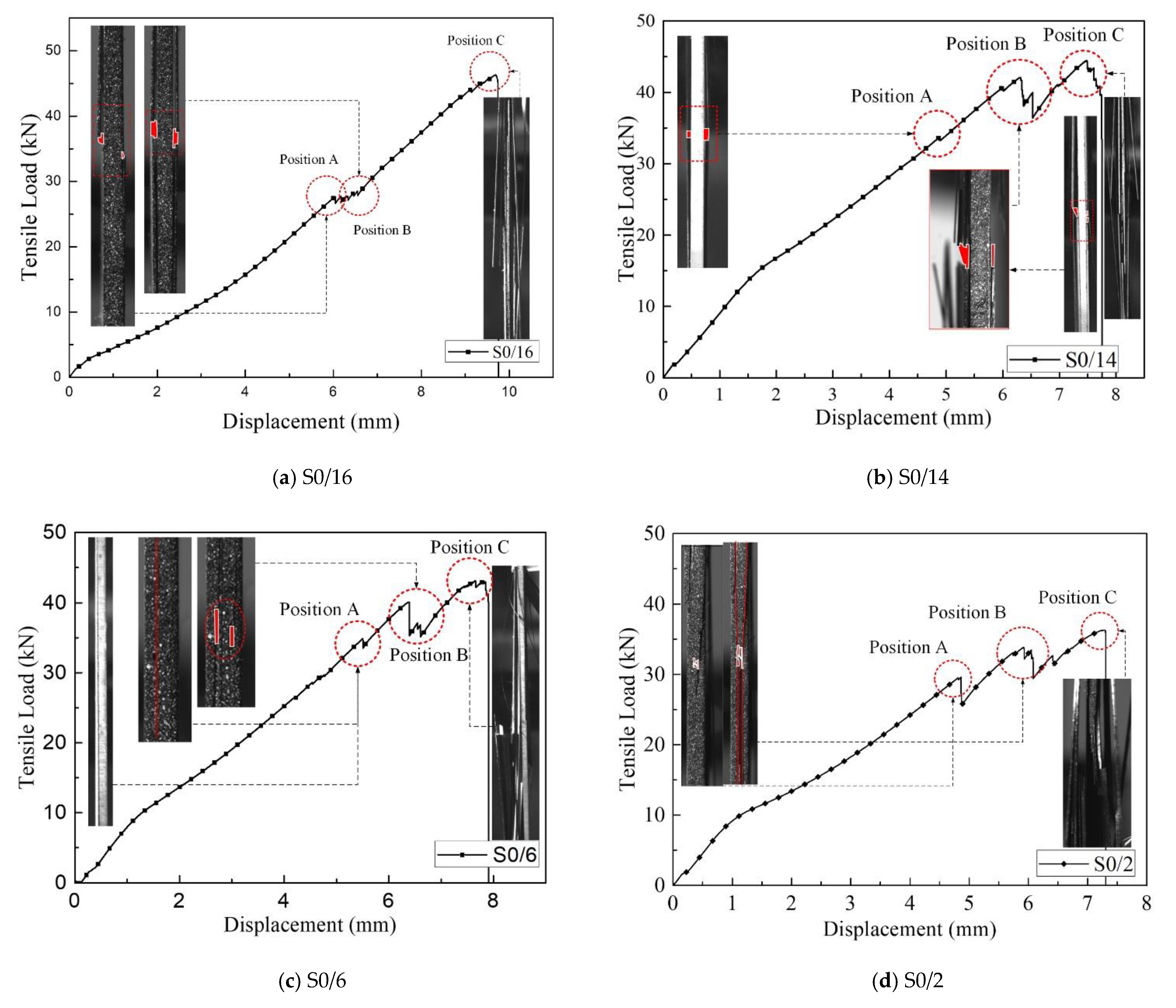
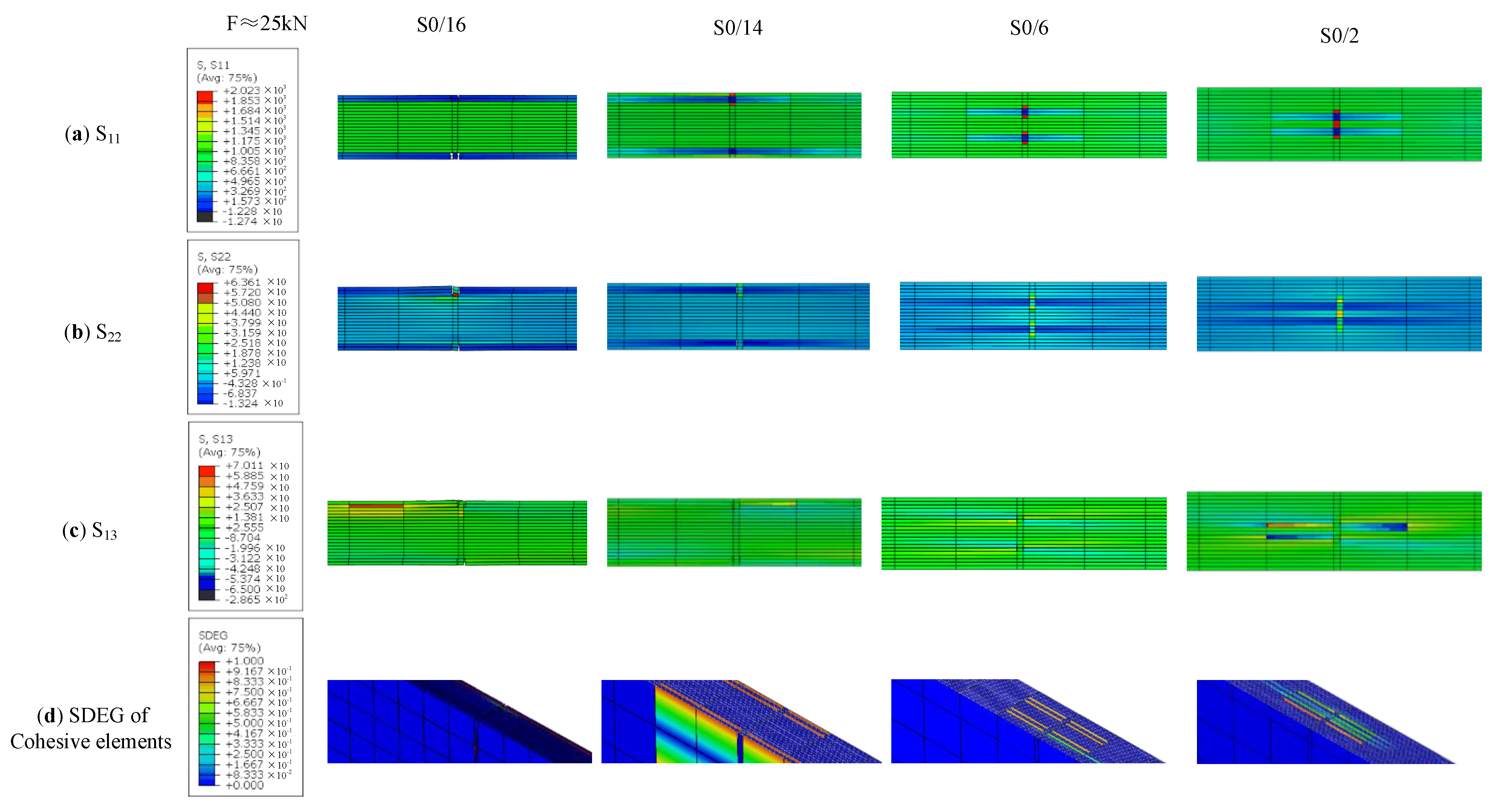
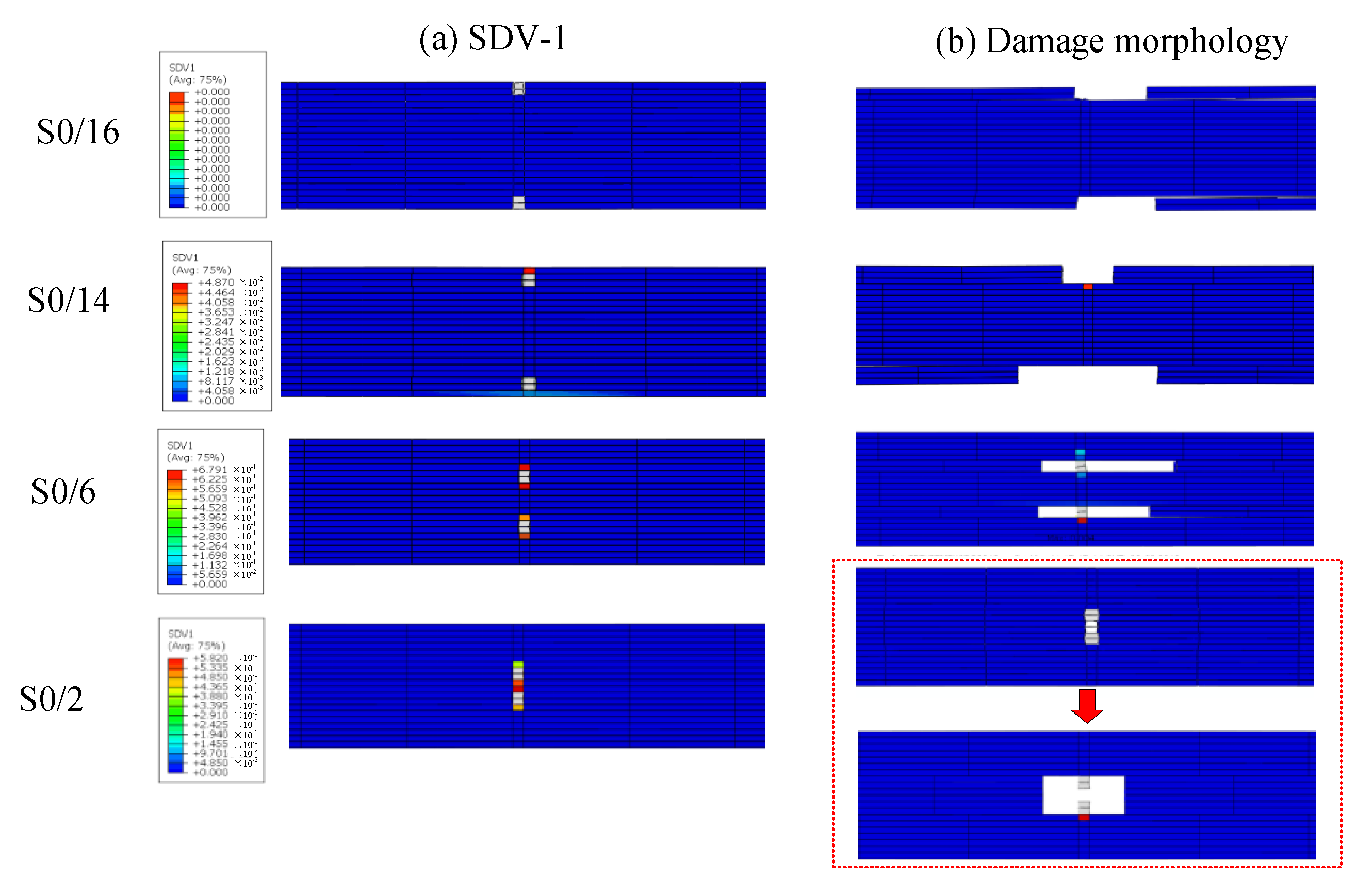

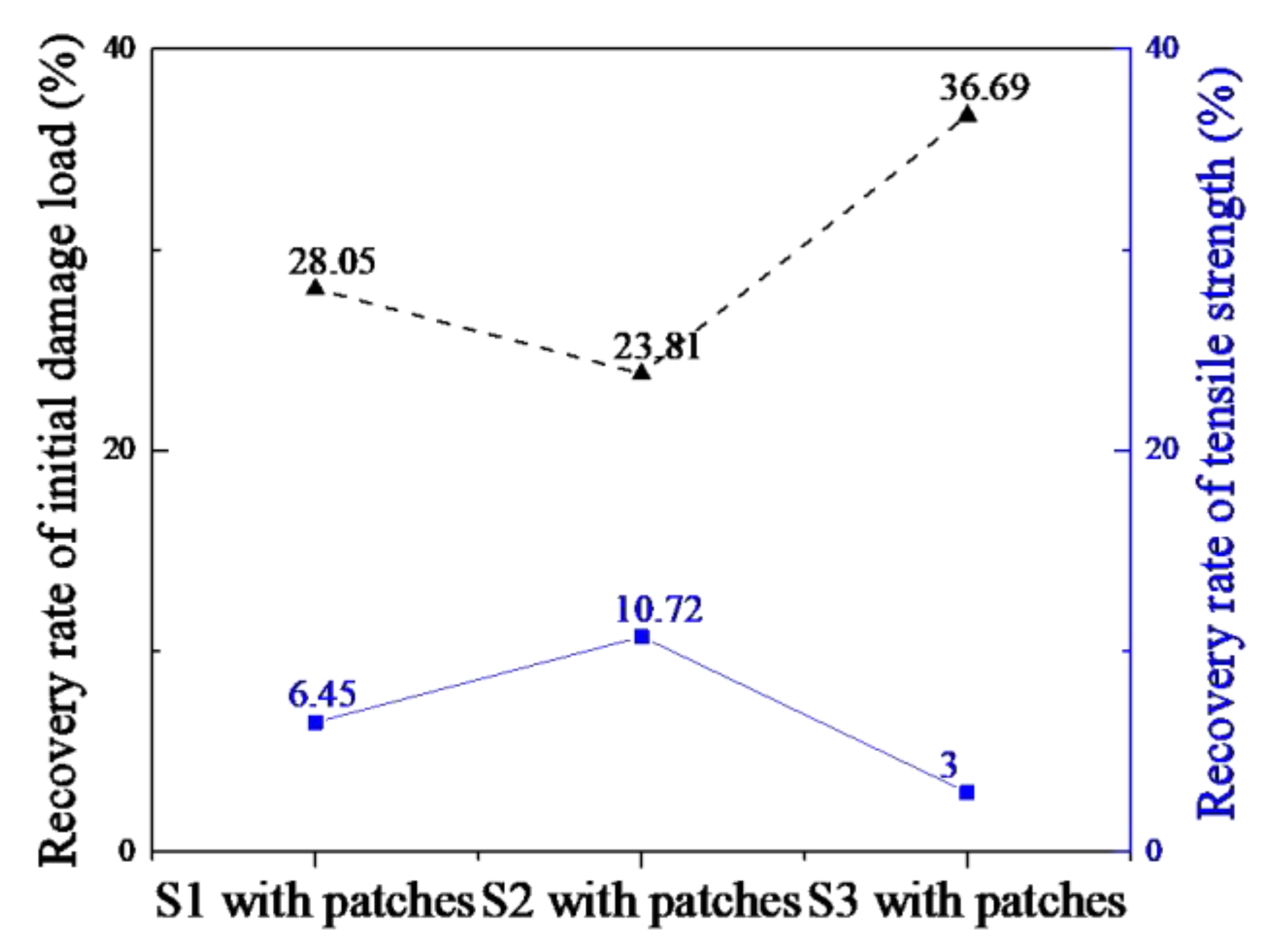

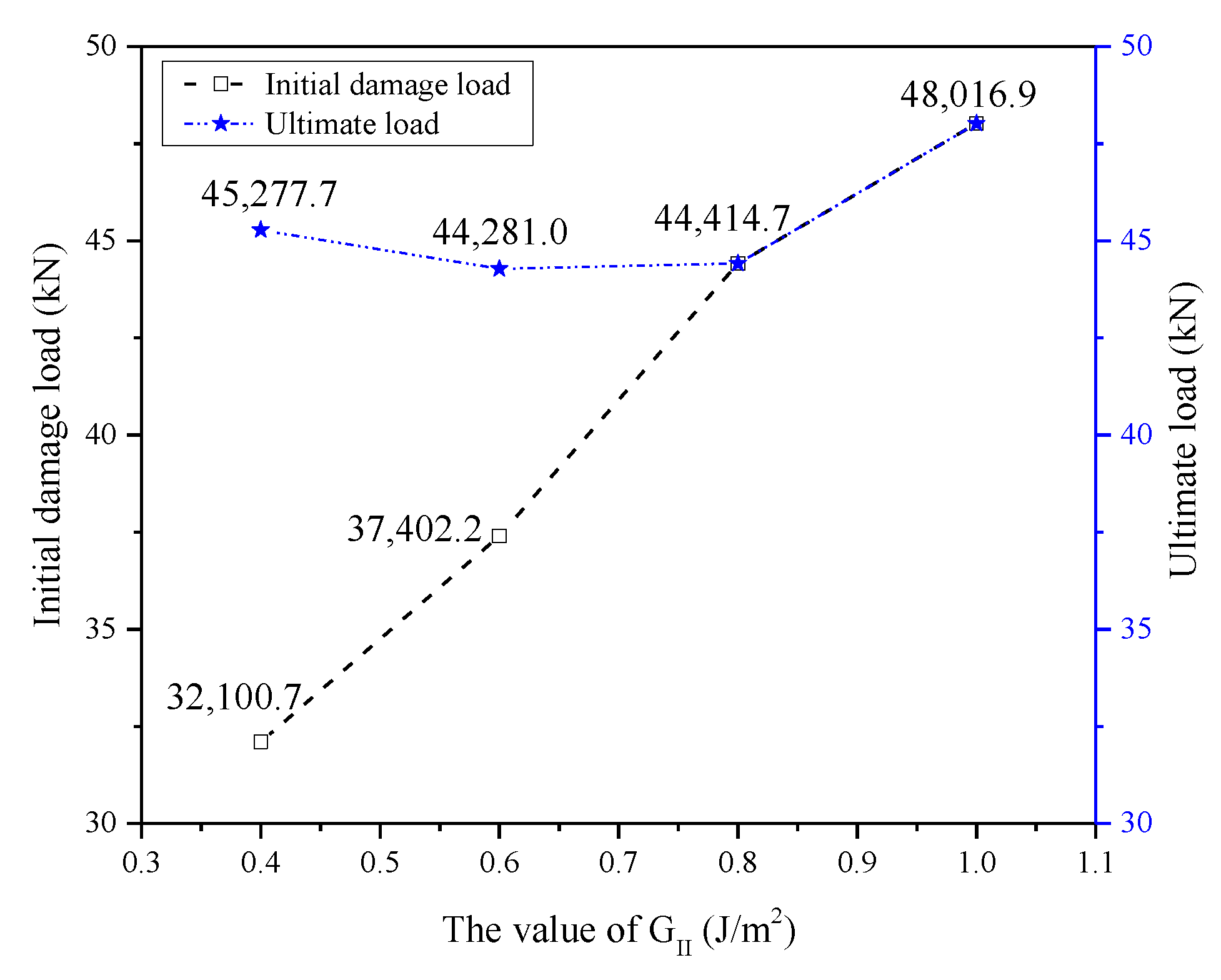
| Material | Mechanical Parameters | Value |
|---|---|---|
| E901 epoxy resin | E/Gpa | 3.78 |
| v | 0.35 | |
| Unidirectional CFRP | E1/Gpa | 127.34 |
| E2/Gpa | 7.78 | |
| E3/Gpa | 7.78 | |
| ν12 | 0.27 | |
| ν13 | 0.27 | |
| ν23 | 0.42 | |
| G12/Gpa | 5.00 | |
| G13/Gpa | 5.00 | |
| G23/Gpa | 3.08 | |
| Xt/MPa | 2114 | |
| Xc/MPa | 704 | |
| Yt/MPa | 80 | |
| Yc/MPa | 68 | |
| S12 = S13/MPa | 80 | |
| S23/MPa | 55 |
| Nmax (MPa) | Smax = Tmax (MPa) | GIC (mJ/mm2) | GIIC = GIIIC (mJ/mm2) | Knn/10−6 | Kss = Ktt/10−6 |
|---|---|---|---|---|---|
| 54.6 | 60 | 0.2 | 0.4 | 3.78 | 1.4 |
| Initial Damage Load | Experimental/N | FEM/N | Error |
|---|---|---|---|
| S0/16 | 27,601.81 | 27,770.6 | 0.61% |
| S0/14 | 31,164.32 | 27,503.2 | 8.82% |
| S0/10 | 33,608.3 | 34,451 | 2.51% |
| S0/6 | 29,872.34 | 32,100.7 | 7.13% |
| S0/2 | 26,748.06 | 23,006.5 | 7.04% |
| Ultimate Load | Experimental/N | FEM/N | Error |
|---|---|---|---|
| D0 | 58,636.92 | 60,601.3 | 3.35% |
| S0/16 | 46,972.66 | 48,210.2 | 2.63% |
| S0/14 | 40,834.36 | 43,555.8 | 6.66% |
| S0/10 | 40,997.75 | 43,338 | 5.71% |
| S0/6 | 43,900.88 | 45,277.7 | 3.14% |
| S0/2 | 39,087.81 | 39,894.3 | 2.06% |
| Specimen | Load/kN | CFRP | Cohesive Element * | |||
|---|---|---|---|---|---|---|
| S11/MPa | S22/MPa | S13/MPa | S23/MPa | S33/MPa | ||
| S0/16 | 27.7 | 2025 | 116.2 | 107.2 | 32.78 | 36.62 |
| S0/14 | 27.5 | 1896 | 27.6 | 53.97 | 33.85 | 8.715 |
| S0/6 | 32.1 | 1973 | 27.54 | 52.69 | 28.24 | 7.88 |
| S0/2 | 23.0 | 1936 | 22.6 | 51.48 | 27.7 | 5.91 |
| Sample | Initial Damage Load/N | Ultimate Load/N | Failure Mode |
|---|---|---|---|
| S1 | 40,341.1 | 49690.8 | I |
| S1 with patches | 51,657.8 | 52896 | III |
| S2 | 43,966.4 | 49162 | II |
| S2 with patches | 54,434.4 | 54434.4 | III |
| S3 | 36,410.1 | 48341.4 | I |
| S3 with patches | 49,769.1 | 49769.1 | III |
© 2019 by the authors. Licensee MDPI, Basel, Switzerland. This article is an open access article distributed under the terms and conditions of the Creative Commons Attribution (CC BY) license (http://creativecommons.org/licenses/by/4.0/).
Share and Cite
Zhu, M.; Chen, D.; Hu, Q. Failure Mechanisms and Reinforcing Modes of Ply Splice Fiber-Reinforced Composite Laminates under Tensile Load. Materials 2019, 12, 2912. https://doi.org/10.3390/ma12182912
Zhu M, Chen D, Hu Q. Failure Mechanisms and Reinforcing Modes of Ply Splice Fiber-Reinforced Composite Laminates under Tensile Load. Materials. 2019; 12(18):2912. https://doi.org/10.3390/ma12182912
Chicago/Turabian StyleZhu, Meng, Dingding Chen, and Qigao Hu. 2019. "Failure Mechanisms and Reinforcing Modes of Ply Splice Fiber-Reinforced Composite Laminates under Tensile Load" Materials 12, no. 18: 2912. https://doi.org/10.3390/ma12182912
APA StyleZhu, M., Chen, D., & Hu, Q. (2019). Failure Mechanisms and Reinforcing Modes of Ply Splice Fiber-Reinforced Composite Laminates under Tensile Load. Materials, 12(18), 2912. https://doi.org/10.3390/ma12182912




